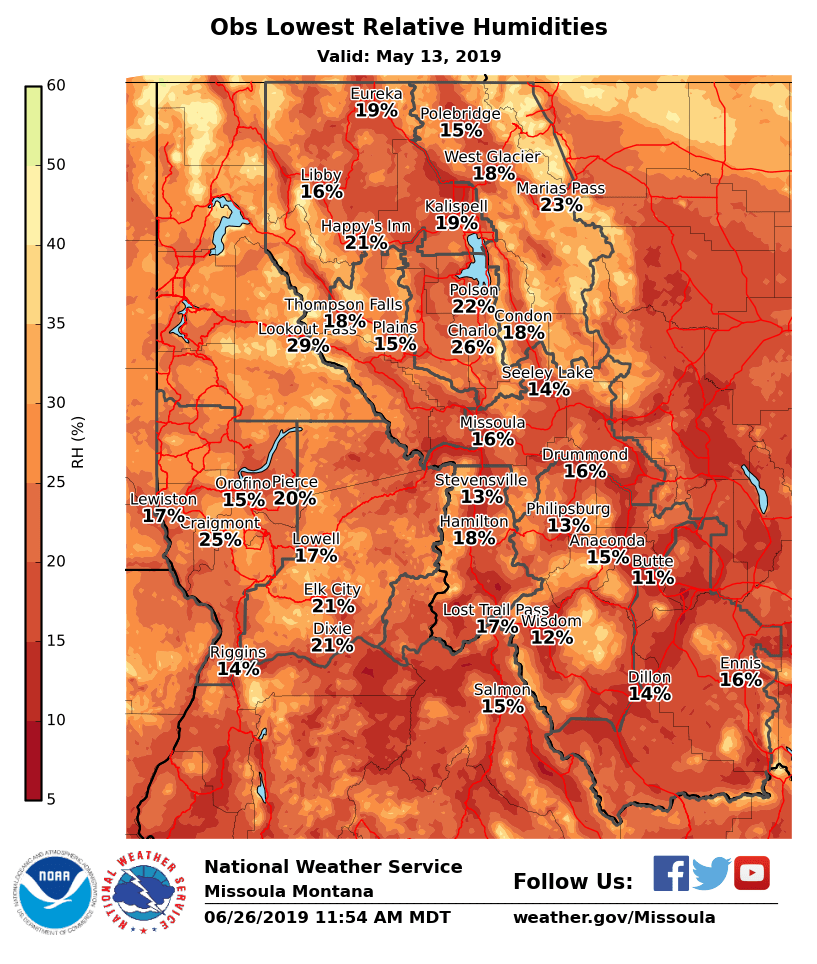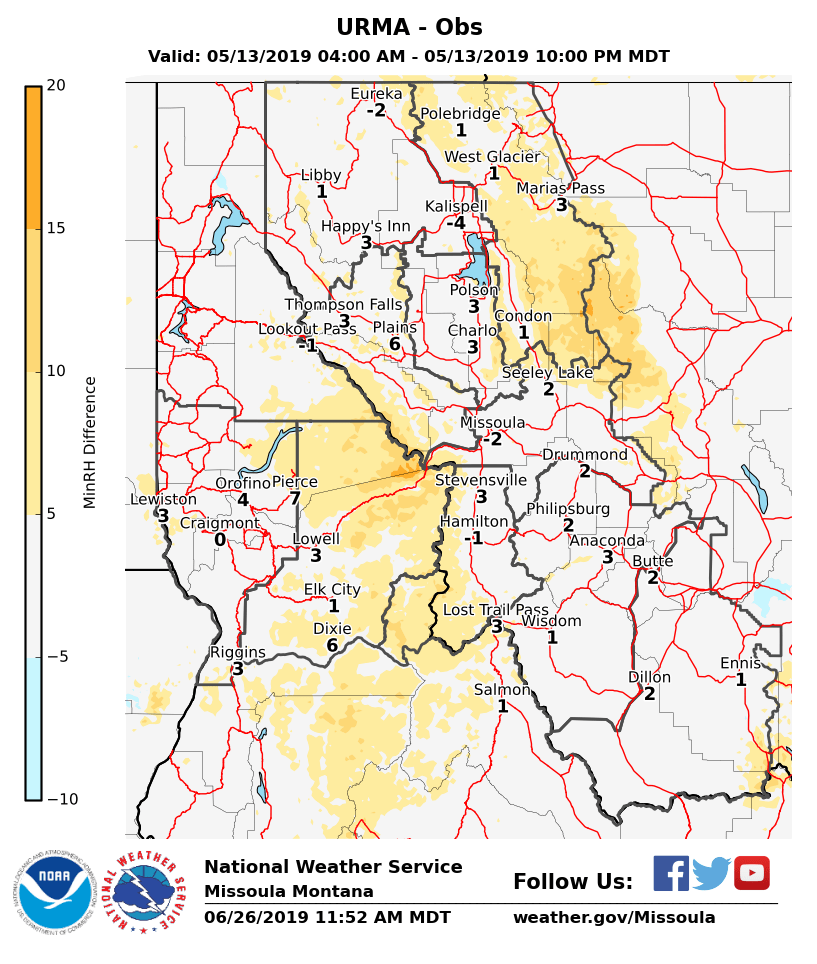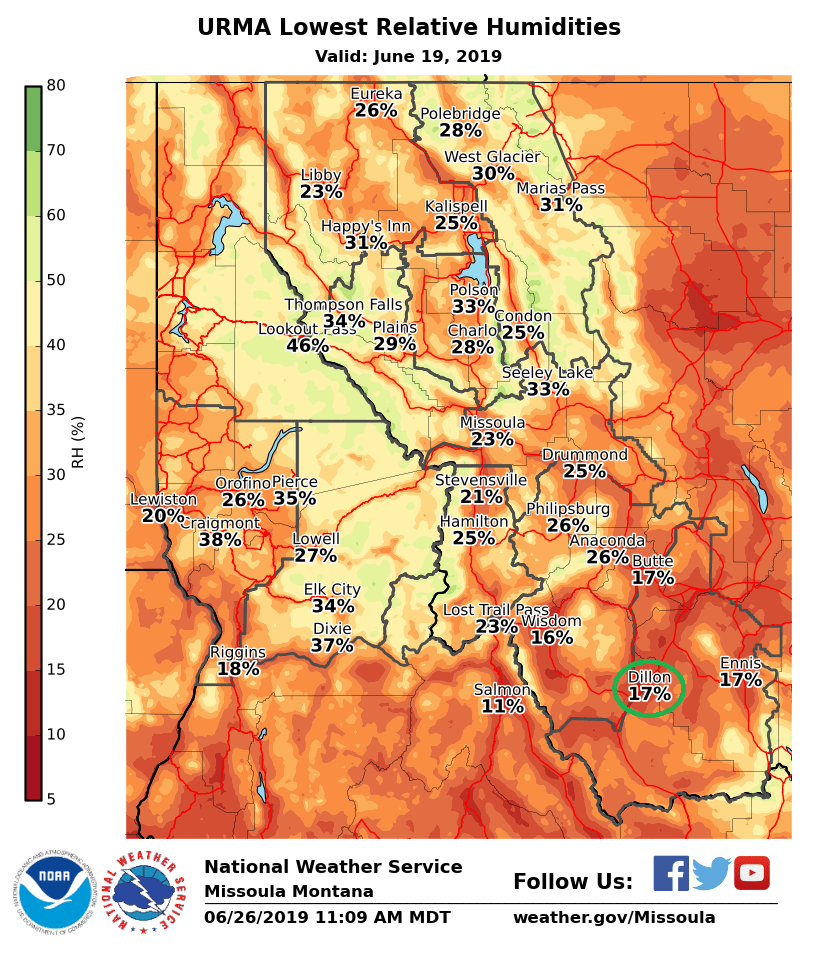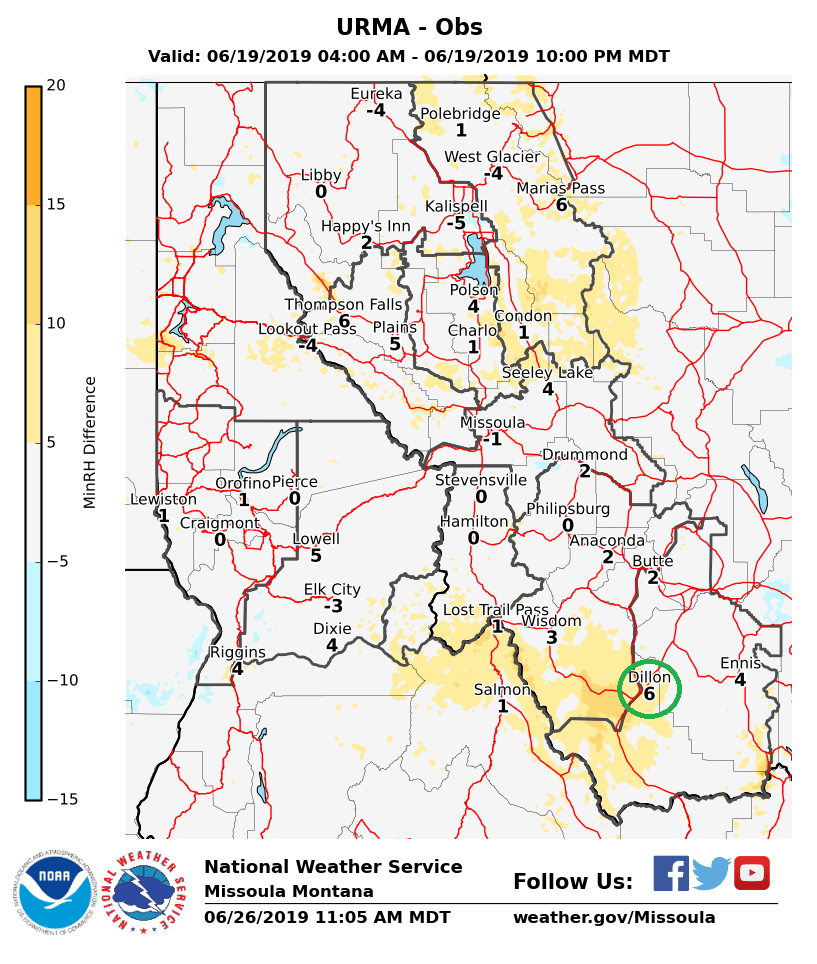All,
An update on the humidity bias in the URMA (which is impacting the
NBM RH downstream). We'll look at two days in particular. The first is
during prescribed fire season for us May 13th. I've attached the Obs
grid analysis, URMA analysis, and a difference grid.

Generally speaking humidity ranged from 30% to the low teens at the
higher elevations and were in the low teens at the lower elevations.
This ranges from and area where prescribed fire burners can just start
to burn to potentially being too dry in other areas. The URMA analysis
is below for comparison.

And below is the difference between the two analysis.

On this day the low elevation temperatures were in the upper 70s with
high elevation temperatures near 60F. The difference image gives a
generous 5% between categories. Doing a rough calculation using a
temperature of 60F, and considering observed humidity in the range
15-25%, in order to get a 5% difference the dew points must have been
different by around 5 degrees. And looking at the shading there are
some areas that have differences in the 15-20% range.
Another day to look at more recently is June 19th. I circled the ASOS
location at Dillion, which reached 11% RH. Generally below 15% is
considered critical for fire weather.

Looking at the URMA analysis below, across much of the area it is
similar, but not in the driest area in SW Montana around Dillon. The
high temperature at Dillon that day was 68F, so a 10F difference in
dew point is required go from 11% to 17% RH.

Below is the difference grid again for comparison.

Below is a list of dates with the difference between the Obs and URMA
for the Hells Half RAWS (HHAI1, 45.65, -114.63, 8100ft). This is a
list of days where the difference was at least 7%.
<pre>
Dates with differences of 7.000000 or more
Date, abs(diff), Obs, URMA
2019040110, 7.999893, 51.998905, 59.998798
2019040210, 7.999124, 41.000940, 49.000064
2019040410, 14.999920, 58.999439, 73.999359
2019040710, 7.999776, 95.999081, 87.999306
2019041110, 20.000203, 87.999493, 67.999290
2019041210, 24.999615, 91.999370, 66.999754
2019041310, 11.000812, 87.999680, 76.998868
2019041410, 19.000080, 87.999493, 68.999413
2019041510, 13.999274, 84.998985, 70.999712
2019041610, 10.000203, 87.999989, 77.999786
2019041810, 7.000833, 34.000214, 41.001047
2019041910, 8.999626, 39.000566, 48.000192
2019042210, 10.999637, 34.000256, 44.999893
2019042410, 15.999685, 32.000182, 47.999866
2019042510, 11.000497, 21.000043, 32.000539
2019042710, 7.999252, 35.001335, 43.000587
2019042810, 7.999765, 83.999081, 75.999316
2019042910, 20.999535, 74.999076, 53.999541
2019043010, 7.000032, 64.999178, 57.999145
2019050110, 8.000417, 23.000123, 31.000539
2019050210, 7.999696, 36.000769, 44.000465
2019050510, 9.000454, 33.000855, 42.001308
2019050810, 10.999380, 46.000091, 56.999471
2019050910, 8.000593, 31.000283, 39.000876
2019051310, 9.999973, 20.000304, 30.000278
2019051810, 7.000865, 84.999957, 77.999092
2019052410, 8.000198, 49.000320, 57.000518
2019052510, 17.001250, 56.998659, 73.999909
2019052710, 7.001164, 64.998772, 71.999936
2019052910, 9.999776, 32.001047, 42.000822
2019053010, 12.997906, 40.001111, 52.999017
2019060310, 7.000091, 43.999535, 50.999626
2019061610, 9.999546, 35.000790, 45.000336
2019061810, 9.998227, 39.000855, 48.999081
2019062110, 7.999541, 91.999498, 83.999957
2019062410, 9.999573, 51.999573, 61.999145
2019062510, 7.999327, 55.999877, 63.999204
</pre>
Digging through the verification it seems the URMA wet bias is mostly
at high elevations, with a much more mixed bag at lower elevations.
My main concern is why aren't the Obs in the area being more closely
matched? (More on that from Chris I think.)
This data is
very important to us because of how it affects
the NBM forecast. The humidity is used by our "deep core
partners" in wildland fire. They are using it to run models that
forecast fuel moisture (very dependent on RH) out to 7 days. These
models are used to forecast/calculate fire danger (NFDRS) and the
Severe Fire Weather Threat Index. These are used on a regional and
national level as input for making decisions about where to allocate
resources including fire fighting crews and aviation assets like
helicopters and air tankers for fighting fire. So this data really
matters and has an impact. Recently a weather forecaster at one of the
regional centers told us that they use the NDFD MinRH when briefing,
and that they've had to say, "but it will probably get lower than
this today," when using it in briefings lately.



